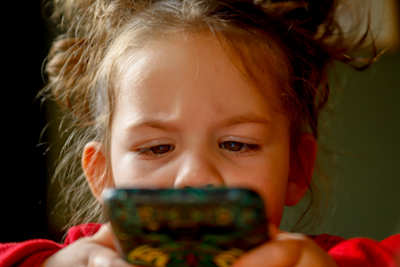
WHO Guidelines: Children and Screen Time
On the 24th of April 2019, the World Health Organization (WHO) released new guidelines on how much time children under five should spend in front of a screen. Most parents and caregivers, particularly those who use screen time as a way of keeping their children quiet or safe, are unaware of the health risks associated with this behaviour.
Pessimism bias,[1] means that our brains are wired in such a way that we are likely to acknowledge negative rather than positive news. Based on this, the media will always be more inclined to show and share content which is negative,[2] making us feel as though the world is a more dangerous place than it really is. With social media, an echochamber is created, making this distributed negativity even more commonplace.
Despite the way the media portrays modern times, the world is in fact safer than it has ever been[3] and yet parents and caregivers still prefer when their children are indoors.
Understanding the development phase
Children develop quickly, both physically and mentally during their early childhood years. It is during this time that the lifestyle habits of a family are adapted by the child and habits are formed, both good and bad.
These habits can be changed later on in life but it can be difficult to do so. The best start in terms of forming healthy habits, begins with learned behaviour from parents or caregivers and it is parents or caregivers who need to take responsibility for the habits of their children.
In the WHO guidelines, a crucial point is made about considering the whole day and structuring it for a child. Encouraging outdoor or simply offline activities which get children moving, as part of their routine, will make a difference.
Taking 24 hours and making sure that a child gets enough sleep, physical activity, nutrition and education can be difficult but it’s worth it when you consider that whichever habits are formed during those first five years will impact the rest of their life.
Childhood obesity is preventable
Sedentary lifestyles are largely to blame for the rise in childhood obesity. This, combined with the lack of nutritional education for parents or caregivers who need help, is a major issue.
When we consider how much time children used to spend ‘playing out’ and compare it to today, there’s a significant difference. If we compare the amount of time a modern child plays outside to the amount of time their parents or caregivers played outside as children, there’s an even greater difference.
A study conducted by the UK government found that 10% of respondents had not been to a beach, park, forest or other natural environment, for at least a year.[4] In the US, the Seattle Children’s Research Institute, in the Archives of Pediatric & Adolescent Medicine found that approximately 50% of preschoolers ‘lacked even one parent-supervised outdoor play session per day. On average, children aged 10 to 16 now spend only 12.6 minutes a day on vigorous outdoor activity compared with 10.4 waking hours being relatively motionless.’[5]
Children should be involved in outdoor activities whenever possible.
Actionable advice for parents or guardians
Infants under one year old, should have no screen time. At this age, the child should not be restrained for more than 1 hour at a time (strollers/prams, high chairs, etc.). They should have 14–17 hours (0–3 months of age) or 12–16 hours (4–11 months of age) of good quality sleep, including naps.
For children aged 1–2 years of age, screen time is not recommended. For those aged 2 years, sedentary screen time should be no more than 1 hour; less is more. Children should spend at least 180 minutes engaged in a variety of types of physical activities during the day and should not be restrained for more than 1 hour at a time (strollers/prams, high chairs, etc.). They should have 11–14 hours of good quality sleep, including naps.
Children 3–4 years of age should have no more than 1 hour of sedentary screen time. Children should spend at least 180 minutes engaged in a variety of types of physical activities during the day and should not be restrained for more than 1 hour at a time (strollers/prams, high chairs, etc.). They should have 10–13 hours of good quality sleep, including naps.
Focusing on setting a good example is important. Whether you’re a parent, guardian, sibling, relative, teacher or family friend, you can help positively influence the lives of children by being healthier and spending less time in front of a screen.
Don’t use your phone or tablet in front of a child under the age of five if you can help it. Try to do a different fun activity with them such as singing or colouring in and give them your undivided attention.
Remember that when you’re spending time with a child, they come first, that call can wait, that picture your friend shared on social media can wait, that article you wanted to read, can wait. Everything will still be there when you come back to it later.
Don’t be afraid to say no. If you have already noticed bad habits forming in your child’s behaviour with regards to screen time, it isn’t too late. Your child will get over it, accept that there will be tears and tantrums but stay strong, say no.
If you need to make a call in front of a child, try using a feature phone instead of a smartphone, that way the child will be less distracted and won’t want to play with the phone when you’re finished.
When you look closely at the WHO’s guidelines you’ll realize that the problem isn’t as much about screen time as it is about spending time with the children placed in front of the screens. Parents and caregivers need to recognize and take responsibility for their actions. Being consciously aware of how our actions influence the youngest among us, will help shape a more conscious generation.
They are the future and it’s our job, as adults, to guide them in the right direction.
We have written more about this topic in the Digital Parenting section of our journal, in posts such as ‘Don’t Let Your Child Use Wireless Devices Before They’re Two’ and ‘How Old Should Your Child Be Before Owning a Smartphone?’.
You can read the full WHO’s full guidelines on physical activity, sedentary behaviour and sleep for children under five years of age, here.
Is there anything you’d like to add, have we missed anything? If you’re interested in sharing your experiences with us or writing a guest post for us, send us an email via hello@mudita.com!
Please feel free to get in touch via social media (send us some photos or videos too), you can find us on Facebook, Twitter and Instagram, let’s connect! To learn more about Mudita, take a look at our website and our other posts.
If you enjoyed reading this article, please share and recommend it!
Related stories

How to Introduce Technology To Your Kids From An Early Age
Cristin Howard writes about all of the different ups and downs of parenting, provides solutions to common challenges.

How Old Should Your Child Be Before Owning a Smartphone?
Before you give your child a smartphone, consider all of the pros and cons. If a child gets an electronic device too soon, it may cause some issues.

Mindfulness and your Child’s Mental Health
One great way to help your child become a healthy, emotionally stable human being is by fostering their ability to be present. Mindfulness can help.
If you'd like to receive the best stories from our blog, keep up to date with our progress and get notified about our product releases and special discounts.